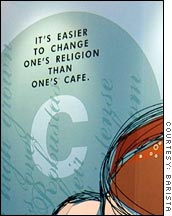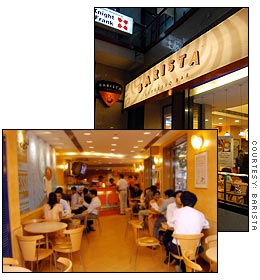NEW YORK (CNN/Money) -
Who says coffee isn't everybody's cup of tea? Just ask Starbucks chairman Howard Schultz.
Here's an example: Seattle, Wash.-based Starbucks took on a formidable tea-drinking nation when it made a foray into China, opening its first cafe on the mainland in 1999.
"China traditionally has been a tea-drinking country but we turned them into coffee drinkers," Schultz told a gathering of analysts earlier this month.
Today, the company operates 8,000 cafes worldwide, including over 100 locations in China. Its long-term expansion goal is to have 30,000 cafes worldwide.
India, on pace to become the most populous country in the world after China, produces the most tea in the world and also consumes the most tea.
Strangely enough, India could be next on Starbucks' list of hot new markets for gourmet coffee outside of the United States.
But maybe not for another two to three years, according to Martin Coles, president of Starbucks (Research) Coffee International.
"India is an important long-term growth opportunity in the Asia/Pacific region," said Coles. "We're approaching the Indian market in a thoughtful way and it's important for us to be observers of the Indian market first."
Both India and China are still small players in terms of domestic coffee consumption. China has one of the world's smallest coffee markets whereas India ranks 36th out of 53 nations with the most sales of packaged coffee, according to market research firm ACNielsen. The United States tops the list, followed by Germany, France, Japan and Italy.
However, patterns are shifting in India and China due in part to changing consumer aspirations and a keenness to indulge in the "Western" experience.
 |
|
| Local Indian cafe bars like Barista say they're confident customers will stay loyal even if Starbucks comes knocking. (A wall poster in a Barista cafe in India) |
"Our point of entry in China was different. Consumers weren't initially drawn to Starbucks for the coffee but for the opportunity to socialize outside of the home," said Christine Day, president of Starbucks Asia Pacific Group.
Said Day, "India is a tea-based culture. We're not saying coffee is a substitute. We're saying Starbucks is a place to hang out, to eat and drink, to see and be seen."
Starbucks captured a niche market early in China. It's a slightly different story in India, where a coffee revolution has been quietly brewing and the retailer may already have lost the first-mover advantage.
Battle of the Baristas
Industry reports suggest that India's nascent gourmet coffee market holds the potential for 5,000 cafes over the next 5 years.
New Delhi-based Barista Coffee Company opened its first "coffee bar" in India four years ago. Today it operates 130 cafes around the country, which bear an uncanny resemblance to Starbucks.
The company is quick to dismiss any comparisons.
"Our inspiration was the traditional Italian Espresso bars where the idea is to create a 'home away from home," said Brotin Banerjee, vice president of marketing with Barista.
 |
|
| India's Barista cafes offer similar gourmet coffee drinks to Starbucks and Wi-Fi access in a handful of locations. |
Barista's menu features everything from a latte to cappuccino, caramel cafe, cafe mocha, flavored coffee and deserts like brownies and cakes. The company also recently introduced Wi-Fi access in 35 locations. Music downloads could be next. Sound familiar?
Regular patrons at Barista are students and young professionals 18 to 35 years old. "With the liberalization of the economy, there are a large number of young Indians with good jobs and attractive incomes," said Banerjee. "Many still live with their parents. So their income is largely disposable and they need to spend it on something. Why not on gourmet coffee?"
Which explains why the average cost of coffee at Barista is nearly 10 times that of a local restaurant's. Barista estimates double-digit growth going forward, citing its unique concept in India and its leadership position.
At the same time, the company is keeping tabs on Starbucks. "We've been hearing about them coming [to India] for the last 3 to 4 years. We don't know why they're not here yet. If they do come, we still believe we have a number of factors to our advantage."
Barista already has a brand identity and customer loyalty. "We also have the prime locations in big metro cities."
Not so fast, says Starbucks.
"Without sounding arrogant, we're looking at our own strategy. There's nothing that keeps us doing business in India," said Starbucks' Cole. No doubt, like other international companies, Starbucks is keen to tap into India's burgeoning middle class market of 200 million people.
"From an economic and cultural standpoint, India is unique," Cole said. "We believe there is a growing affinity for global brands, particularly among the middle class."
However, unlike its domestic approach where its stores are largely company-owned, government regulations in India will require Starbucks to either form joint ventures with local players or create franchise operations.
Apparently that's not an issue, said Coles, since the company faced a similar hurdle in China and opted for the joint venture route.
For critics who say a $3.50 cup of Starbucks coffee is unlikely to win over fans immediately in a country where the average per capita income per month among India's vast middle class population is about $680 a month -- well -- Barista has proven that's not the case.
Nevertheless, industry watchers speculate Starbucks would probably adjust its pricing strategy somehwhat to better adapt to the Indian market.
"Starbucks has learned several lessons in China. One is that it really doesn't need to go after the masses," said Matthew Difrisco, analyst with Harris Nesbitt. "All it needs is the upper 10 percent of India's booming middle class to support a base of 100 stores and then go from there."

|

